ACCT 2013 Cost Management: BlindsforShine Limited Financial Case Study
VerifiedAdded on 2023/06/03
|7
|1414
|386
Case Study
AI Summary
This case study assignment focuses on evaluating the financial performance of BlindsforShine Limited, a luxury blinds manufacturer, for November 2018. The CEO is concerned about a recent decline in financial performance and has requested a budget report. The analysis involves computing flexible budget variances and sales volume variances to assess the company's financial stability. Variances in revenue, direct material costs, direct labor costs, variable overhead, and fixed manufacturing costs are examined to identify the causes behind unfavorable operating profit. Recommendations are provided to improve revenues and control costs, aiming to enhance the overall financial health of BlindsforShine Limited.
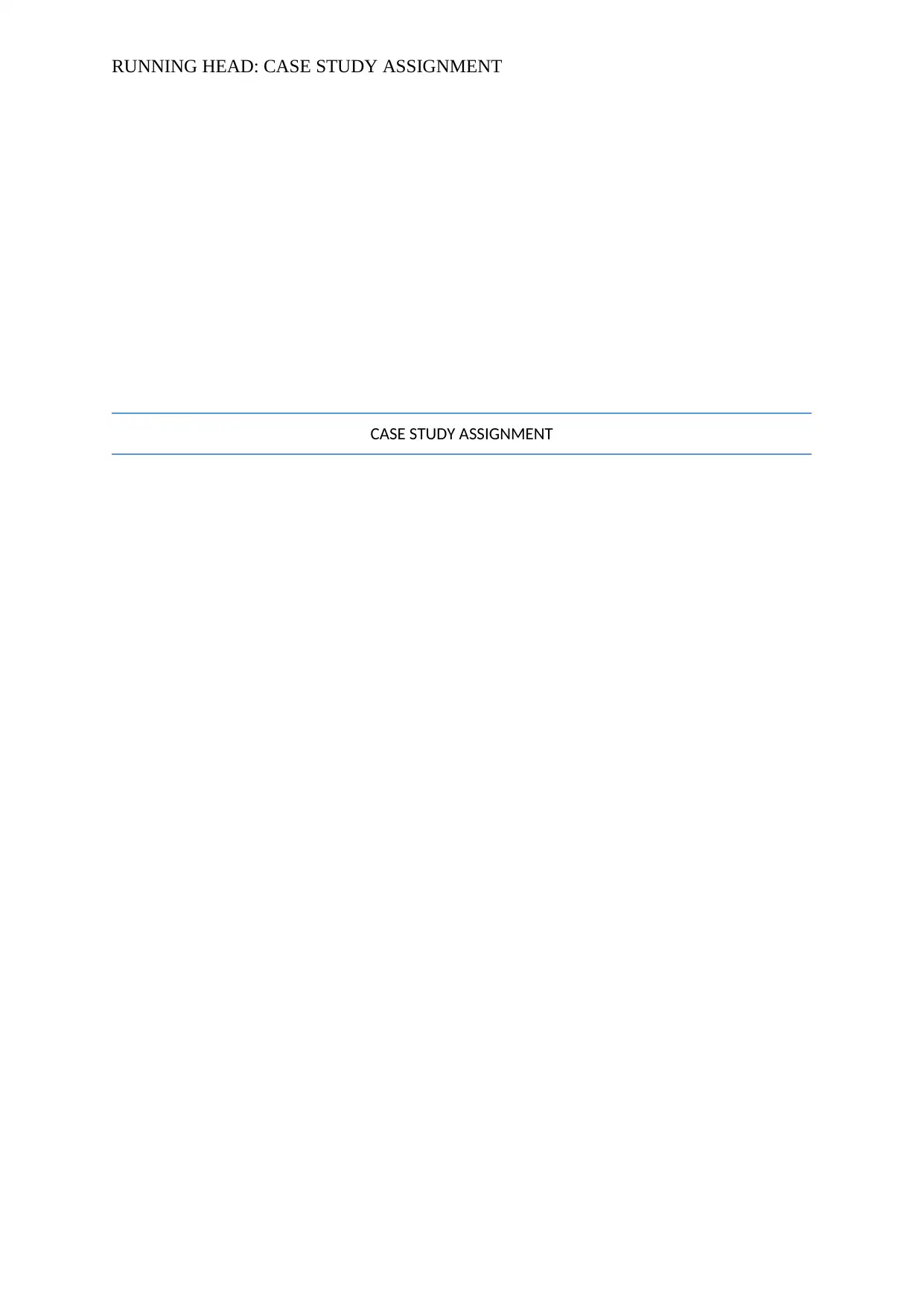
RUNNING HEAD: CASE STUDY ASSIGNMENT
CASE STUDY ASSIGNMENT
CASE STUDY ASSIGNMENT
Paraphrase This Document
Need a fresh take? Get an instant paraphrase of this document with our AI Paraphraser
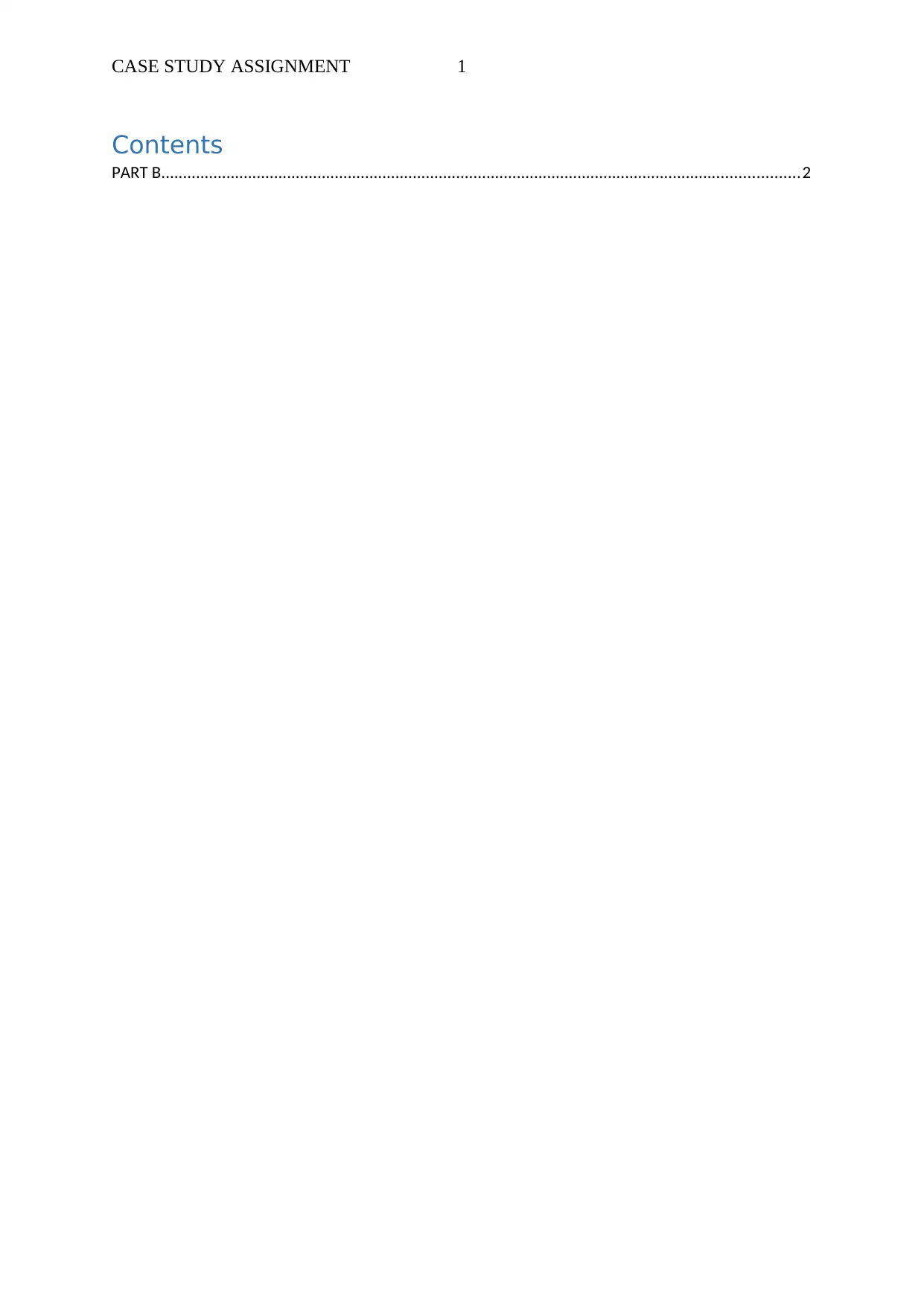
CASE STUDY ASSIGNMENT 1
Contents
PART B...................................................................................................................................................2
Contents
PART B...................................................................................................................................................2
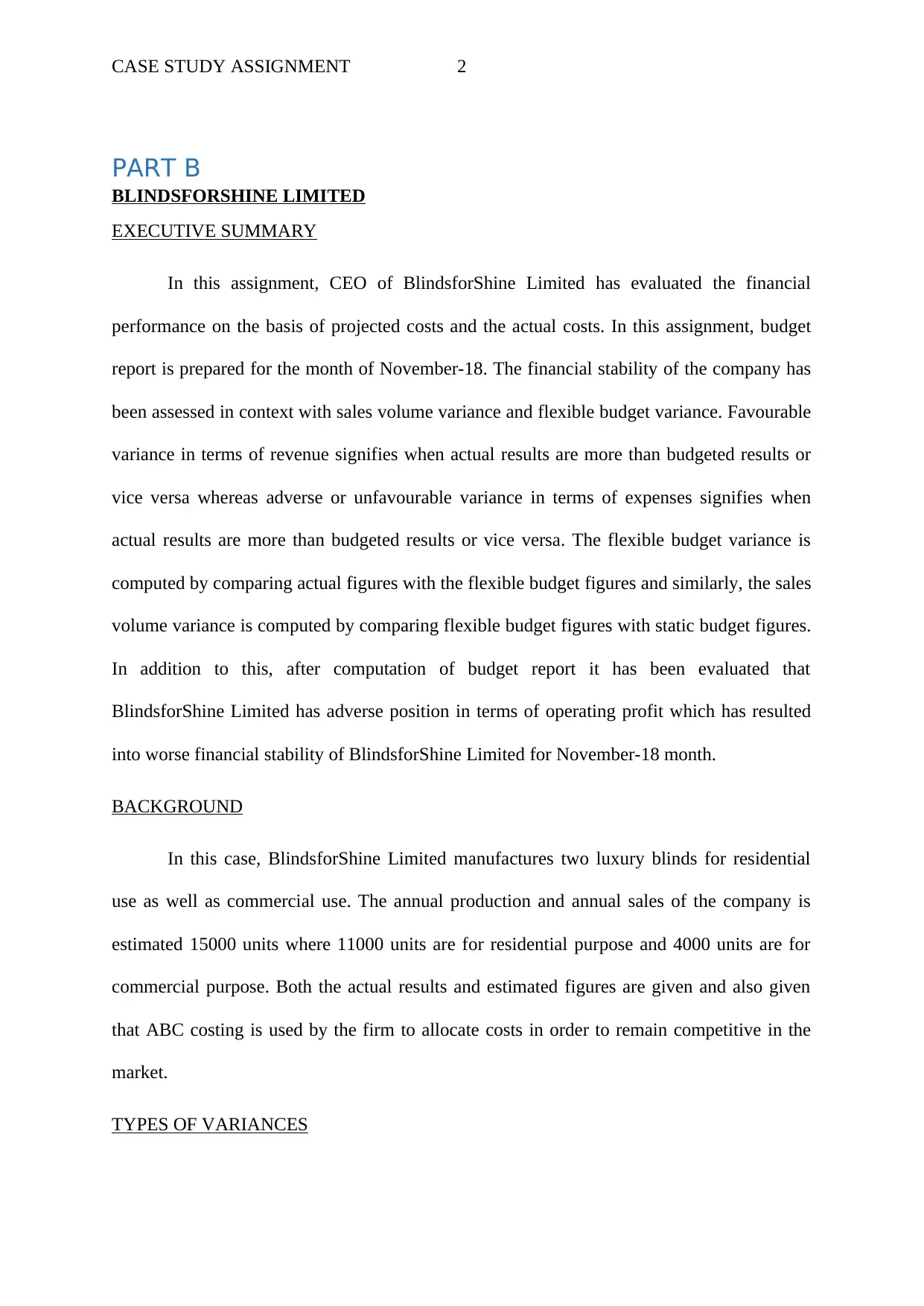
CASE STUDY ASSIGNMENT 2
PART B
BLINDSFORSHINE LIMITED
EXECUTIVE SUMMARY
In this assignment, CEO of BlindsforShine Limited has evaluated the financial
performance on the basis of projected costs and the actual costs. In this assignment, budget
report is prepared for the month of November-18. The financial stability of the company has
been assessed in context with sales volume variance and flexible budget variance. Favourable
variance in terms of revenue signifies when actual results are more than budgeted results or
vice versa whereas adverse or unfavourable variance in terms of expenses signifies when
actual results are more than budgeted results or vice versa. The flexible budget variance is
computed by comparing actual figures with the flexible budget figures and similarly, the sales
volume variance is computed by comparing flexible budget figures with static budget figures.
In addition to this, after computation of budget report it has been evaluated that
BlindsforShine Limited has adverse position in terms of operating profit which has resulted
into worse financial stability of BlindsforShine Limited for November-18 month.
BACKGROUND
In this case, BlindsforShine Limited manufactures two luxury blinds for residential
use as well as commercial use. The annual production and annual sales of the company is
estimated 15000 units where 11000 units are for residential purpose and 4000 units are for
commercial purpose. Both the actual results and estimated figures are given and also given
that ABC costing is used by the firm to allocate costs in order to remain competitive in the
market.
TYPES OF VARIANCES
PART B
BLINDSFORSHINE LIMITED
EXECUTIVE SUMMARY
In this assignment, CEO of BlindsforShine Limited has evaluated the financial
performance on the basis of projected costs and the actual costs. In this assignment, budget
report is prepared for the month of November-18. The financial stability of the company has
been assessed in context with sales volume variance and flexible budget variance. Favourable
variance in terms of revenue signifies when actual results are more than budgeted results or
vice versa whereas adverse or unfavourable variance in terms of expenses signifies when
actual results are more than budgeted results or vice versa. The flexible budget variance is
computed by comparing actual figures with the flexible budget figures and similarly, the sales
volume variance is computed by comparing flexible budget figures with static budget figures.
In addition to this, after computation of budget report it has been evaluated that
BlindsforShine Limited has adverse position in terms of operating profit which has resulted
into worse financial stability of BlindsforShine Limited for November-18 month.
BACKGROUND
In this case, BlindsforShine Limited manufactures two luxury blinds for residential
use as well as commercial use. The annual production and annual sales of the company is
estimated 15000 units where 11000 units are for residential purpose and 4000 units are for
commercial purpose. Both the actual results and estimated figures are given and also given
that ABC costing is used by the firm to allocate costs in order to remain competitive in the
market.
TYPES OF VARIANCES
⊘ This is a preview!⊘
Do you want full access?
Subscribe today to unlock all pages.

Trusted by 1+ million students worldwide
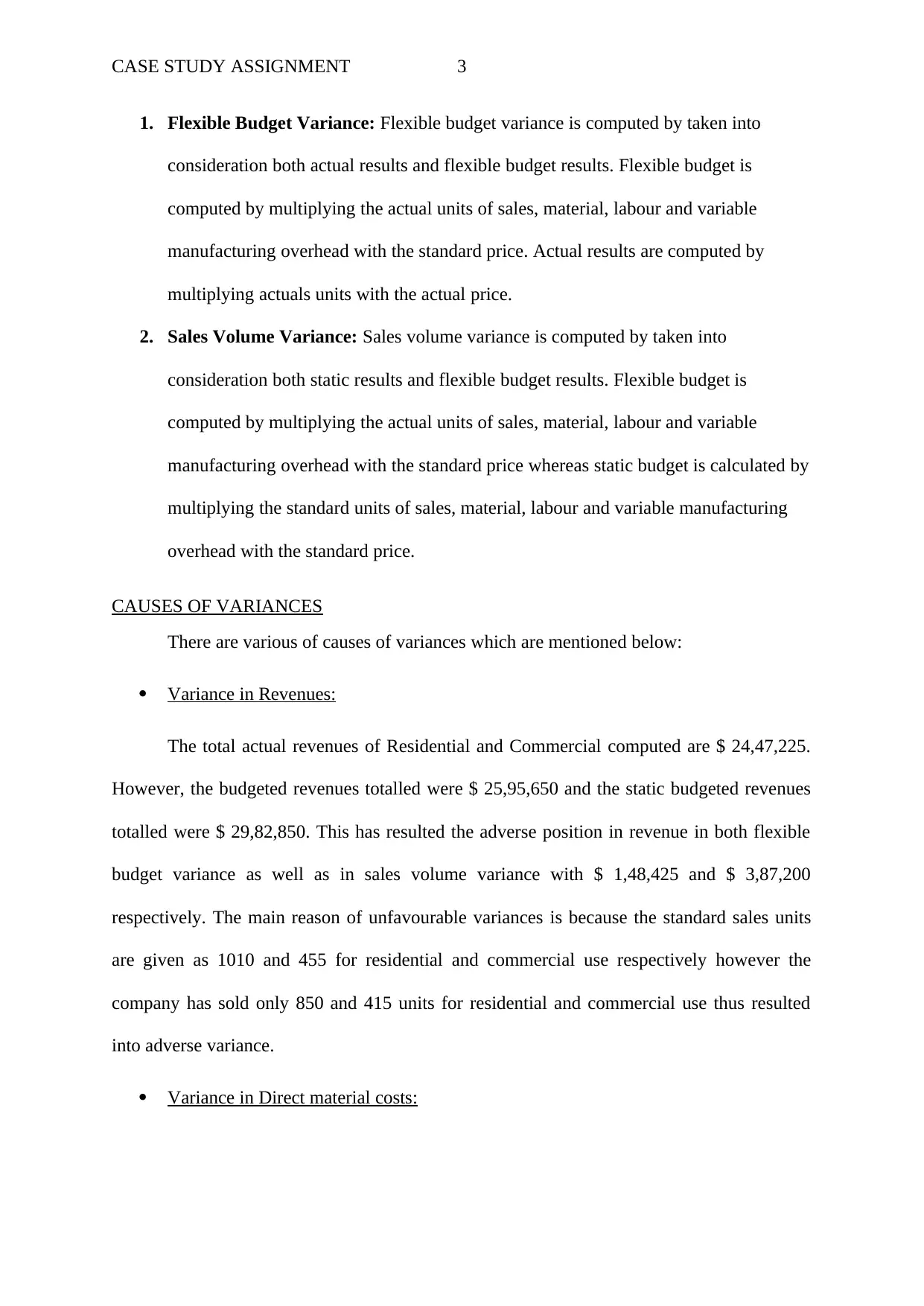
CASE STUDY ASSIGNMENT 3
1. Flexible Budget Variance: Flexible budget variance is computed by taken into
consideration both actual results and flexible budget results. Flexible budget is
computed by multiplying the actual units of sales, material, labour and variable
manufacturing overhead with the standard price. Actual results are computed by
multiplying actuals units with the actual price.
2. Sales Volume Variance: Sales volume variance is computed by taken into
consideration both static results and flexible budget results. Flexible budget is
computed by multiplying the actual units of sales, material, labour and variable
manufacturing overhead with the standard price whereas static budget is calculated by
multiplying the standard units of sales, material, labour and variable manufacturing
overhead with the standard price.
CAUSES OF VARIANCES
There are various of causes of variances which are mentioned below:
Variance in Revenues:
The total actual revenues of Residential and Commercial computed are $ 24,47,225.
However, the budgeted revenues totalled were $ 25,95,650 and the static budgeted revenues
totalled were $ 29,82,850. This has resulted the adverse position in revenue in both flexible
budget variance as well as in sales volume variance with $ 1,48,425 and $ 3,87,200
respectively. The main reason of unfavourable variances is because the standard sales units
are given as 1010 and 455 for residential and commercial use respectively however the
company has sold only 850 and 415 units for residential and commercial use thus resulted
into adverse variance.
Variance in Direct material costs:
1. Flexible Budget Variance: Flexible budget variance is computed by taken into
consideration both actual results and flexible budget results. Flexible budget is
computed by multiplying the actual units of sales, material, labour and variable
manufacturing overhead with the standard price. Actual results are computed by
multiplying actuals units with the actual price.
2. Sales Volume Variance: Sales volume variance is computed by taken into
consideration both static results and flexible budget results. Flexible budget is
computed by multiplying the actual units of sales, material, labour and variable
manufacturing overhead with the standard price whereas static budget is calculated by
multiplying the standard units of sales, material, labour and variable manufacturing
overhead with the standard price.
CAUSES OF VARIANCES
There are various of causes of variances which are mentioned below:
Variance in Revenues:
The total actual revenues of Residential and Commercial computed are $ 24,47,225.
However, the budgeted revenues totalled were $ 25,95,650 and the static budgeted revenues
totalled were $ 29,82,850. This has resulted the adverse position in revenue in both flexible
budget variance as well as in sales volume variance with $ 1,48,425 and $ 3,87,200
respectively. The main reason of unfavourable variances is because the standard sales units
are given as 1010 and 455 for residential and commercial use respectively however the
company has sold only 850 and 415 units for residential and commercial use thus resulted
into adverse variance.
Variance in Direct material costs:
Paraphrase This Document
Need a fresh take? Get an instant paraphrase of this document with our AI Paraphraser
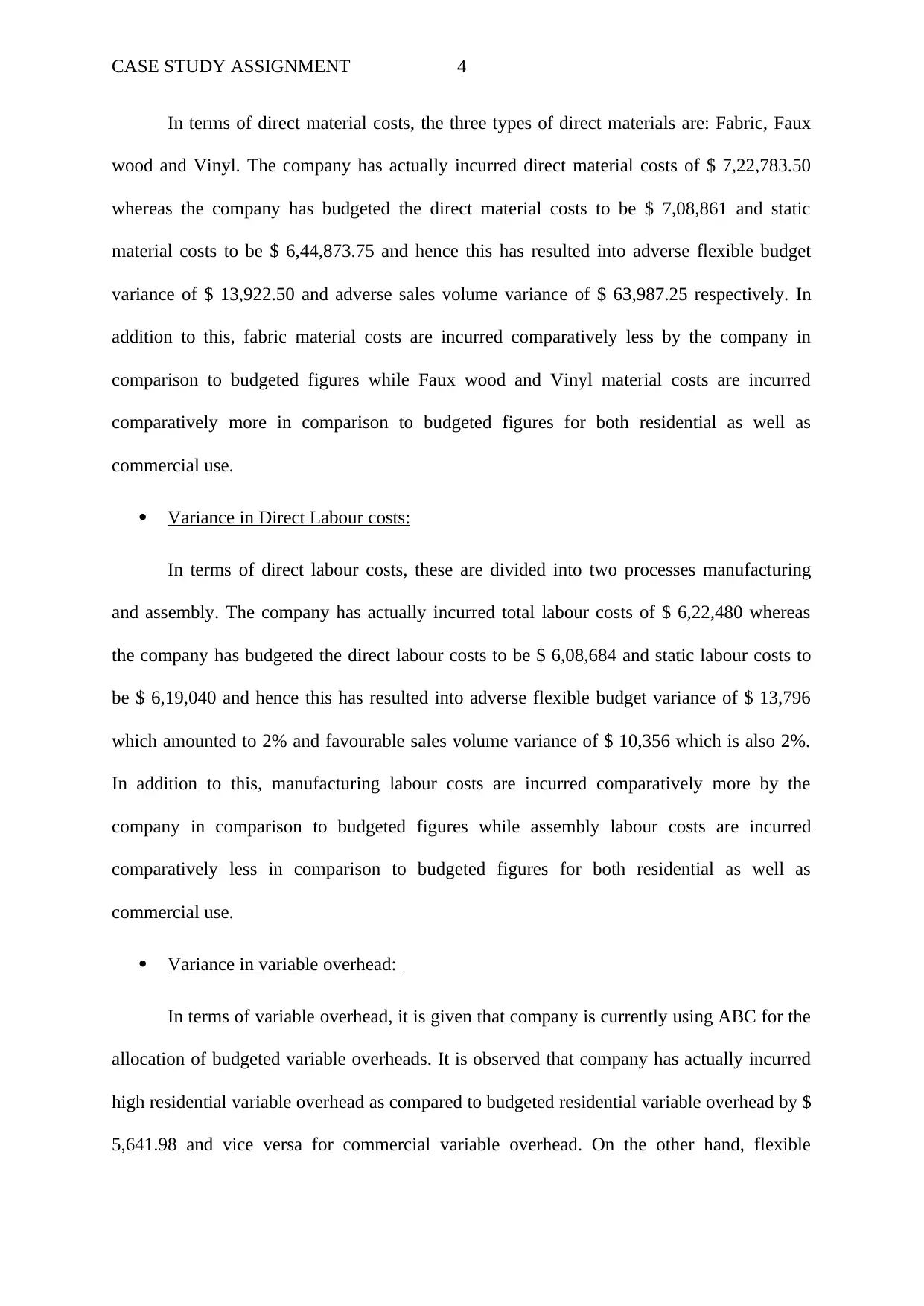
CASE STUDY ASSIGNMENT 4
In terms of direct material costs, the three types of direct materials are: Fabric, Faux
wood and Vinyl. The company has actually incurred direct material costs of $ 7,22,783.50
whereas the company has budgeted the direct material costs to be $ 7,08,861 and static
material costs to be $ 6,44,873.75 and hence this has resulted into adverse flexible budget
variance of $ 13,922.50 and adverse sales volume variance of $ 63,987.25 respectively. In
addition to this, fabric material costs are incurred comparatively less by the company in
comparison to budgeted figures while Faux wood and Vinyl material costs are incurred
comparatively more in comparison to budgeted figures for both residential as well as
commercial use.
Variance in Direct Labour costs:
In terms of direct labour costs, these are divided into two processes manufacturing
and assembly. The company has actually incurred total labour costs of $ 6,22,480 whereas
the company has budgeted the direct labour costs to be $ 6,08,684 and static labour costs to
be $ 6,19,040 and hence this has resulted into adverse flexible budget variance of $ 13,796
which amounted to 2% and favourable sales volume variance of $ 10,356 which is also 2%.
In addition to this, manufacturing labour costs are incurred comparatively more by the
company in comparison to budgeted figures while assembly labour costs are incurred
comparatively less in comparison to budgeted figures for both residential as well as
commercial use.
Variance in variable overhead:
In terms of variable overhead, it is given that company is currently using ABC for the
allocation of budgeted variable overheads. It is observed that company has actually incurred
high residential variable overhead as compared to budgeted residential variable overhead by $
5,641.98 and vice versa for commercial variable overhead. On the other hand, flexible
In terms of direct material costs, the three types of direct materials are: Fabric, Faux
wood and Vinyl. The company has actually incurred direct material costs of $ 7,22,783.50
whereas the company has budgeted the direct material costs to be $ 7,08,861 and static
material costs to be $ 6,44,873.75 and hence this has resulted into adverse flexible budget
variance of $ 13,922.50 and adverse sales volume variance of $ 63,987.25 respectively. In
addition to this, fabric material costs are incurred comparatively less by the company in
comparison to budgeted figures while Faux wood and Vinyl material costs are incurred
comparatively more in comparison to budgeted figures for both residential as well as
commercial use.
Variance in Direct Labour costs:
In terms of direct labour costs, these are divided into two processes manufacturing
and assembly. The company has actually incurred total labour costs of $ 6,22,480 whereas
the company has budgeted the direct labour costs to be $ 6,08,684 and static labour costs to
be $ 6,19,040 and hence this has resulted into adverse flexible budget variance of $ 13,796
which amounted to 2% and favourable sales volume variance of $ 10,356 which is also 2%.
In addition to this, manufacturing labour costs are incurred comparatively more by the
company in comparison to budgeted figures while assembly labour costs are incurred
comparatively less in comparison to budgeted figures for both residential as well as
commercial use.
Variance in variable overhead:
In terms of variable overhead, it is given that company is currently using ABC for the
allocation of budgeted variable overheads. It is observed that company has actually incurred
high residential variable overhead as compared to budgeted residential variable overhead by $
5,641.98 and vice versa for commercial variable overhead. On the other hand, flexible
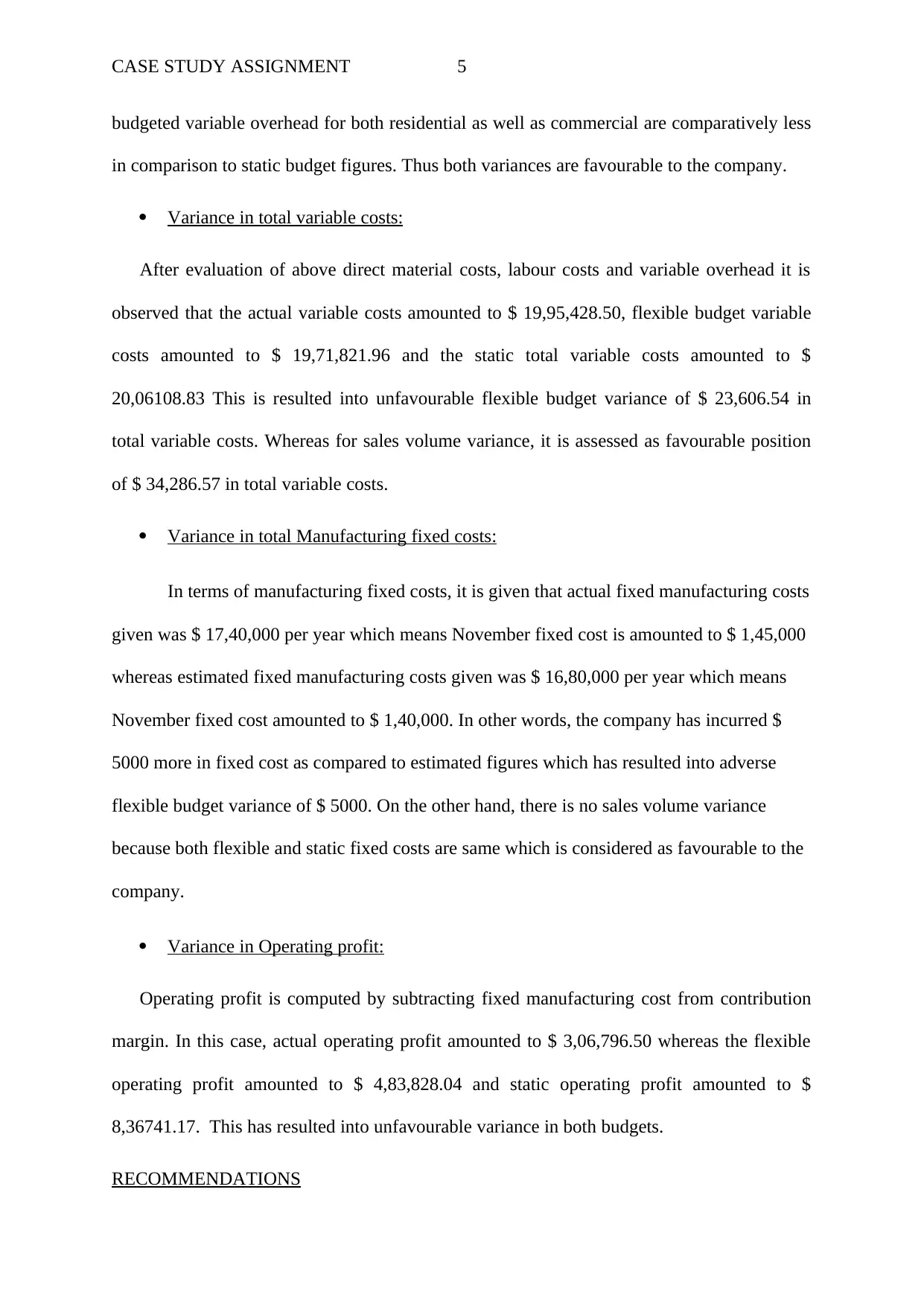
CASE STUDY ASSIGNMENT 5
budgeted variable overhead for both residential as well as commercial are comparatively less
in comparison to static budget figures. Thus both variances are favourable to the company.
Variance in total variable costs:
After evaluation of above direct material costs, labour costs and variable overhead it is
observed that the actual variable costs amounted to $ 19,95,428.50, flexible budget variable
costs amounted to $ 19,71,821.96 and the static total variable costs amounted to $
20,06108.83 This is resulted into unfavourable flexible budget variance of $ 23,606.54 in
total variable costs. Whereas for sales volume variance, it is assessed as favourable position
of $ 34,286.57 in total variable costs.
Variance in total Manufacturing fixed costs:
In terms of manufacturing fixed costs, it is given that actual fixed manufacturing costs
given was $ 17,40,000 per year which means November fixed cost is amounted to $ 1,45,000
whereas estimated fixed manufacturing costs given was $ 16,80,000 per year which means
November fixed cost amounted to $ 1,40,000. In other words, the company has incurred $
5000 more in fixed cost as compared to estimated figures which has resulted into adverse
flexible budget variance of $ 5000. On the other hand, there is no sales volume variance
because both flexible and static fixed costs are same which is considered as favourable to the
company.
Variance in Operating profit:
Operating profit is computed by subtracting fixed manufacturing cost from contribution
margin. In this case, actual operating profit amounted to $ 3,06,796.50 whereas the flexible
operating profit amounted to $ 4,83,828.04 and static operating profit amounted to $
8,36741.17. This has resulted into unfavourable variance in both budgets.
RECOMMENDATIONS
budgeted variable overhead for both residential as well as commercial are comparatively less
in comparison to static budget figures. Thus both variances are favourable to the company.
Variance in total variable costs:
After evaluation of above direct material costs, labour costs and variable overhead it is
observed that the actual variable costs amounted to $ 19,95,428.50, flexible budget variable
costs amounted to $ 19,71,821.96 and the static total variable costs amounted to $
20,06108.83 This is resulted into unfavourable flexible budget variance of $ 23,606.54 in
total variable costs. Whereas for sales volume variance, it is assessed as favourable position
of $ 34,286.57 in total variable costs.
Variance in total Manufacturing fixed costs:
In terms of manufacturing fixed costs, it is given that actual fixed manufacturing costs
given was $ 17,40,000 per year which means November fixed cost is amounted to $ 1,45,000
whereas estimated fixed manufacturing costs given was $ 16,80,000 per year which means
November fixed cost amounted to $ 1,40,000. In other words, the company has incurred $
5000 more in fixed cost as compared to estimated figures which has resulted into adverse
flexible budget variance of $ 5000. On the other hand, there is no sales volume variance
because both flexible and static fixed costs are same which is considered as favourable to the
company.
Variance in Operating profit:
Operating profit is computed by subtracting fixed manufacturing cost from contribution
margin. In this case, actual operating profit amounted to $ 3,06,796.50 whereas the flexible
operating profit amounted to $ 4,83,828.04 and static operating profit amounted to $
8,36741.17. This has resulted into unfavourable variance in both budgets.
RECOMMENDATIONS
⊘ This is a preview!⊘
Do you want full access?
Subscribe today to unlock all pages.

Trusted by 1+ million students worldwide
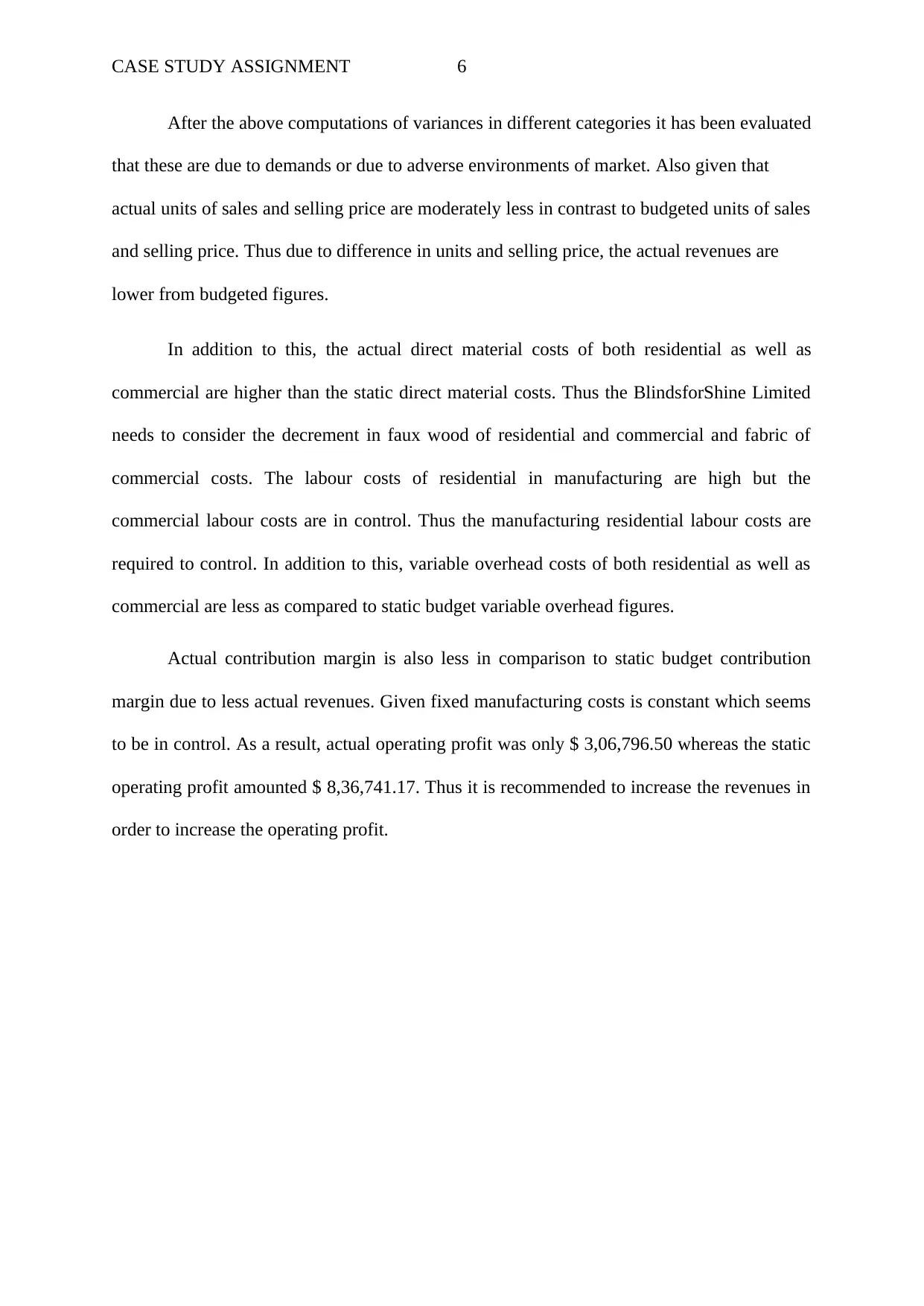
CASE STUDY ASSIGNMENT 6
After the above computations of variances in different categories it has been evaluated
that these are due to demands or due to adverse environments of market. Also given that
actual units of sales and selling price are moderately less in contrast to budgeted units of sales
and selling price. Thus due to difference in units and selling price, the actual revenues are
lower from budgeted figures.
In addition to this, the actual direct material costs of both residential as well as
commercial are higher than the static direct material costs. Thus the BlindsforShine Limited
needs to consider the decrement in faux wood of residential and commercial and fabric of
commercial costs. The labour costs of residential in manufacturing are high but the
commercial labour costs are in control. Thus the manufacturing residential labour costs are
required to control. In addition to this, variable overhead costs of both residential as well as
commercial are less as compared to static budget variable overhead figures.
Actual contribution margin is also less in comparison to static budget contribution
margin due to less actual revenues. Given fixed manufacturing costs is constant which seems
to be in control. As a result, actual operating profit was only $ 3,06,796.50 whereas the static
operating profit amounted $ 8,36,741.17. Thus it is recommended to increase the revenues in
order to increase the operating profit.
After the above computations of variances in different categories it has been evaluated
that these are due to demands or due to adverse environments of market. Also given that
actual units of sales and selling price are moderately less in contrast to budgeted units of sales
and selling price. Thus due to difference in units and selling price, the actual revenues are
lower from budgeted figures.
In addition to this, the actual direct material costs of both residential as well as
commercial are higher than the static direct material costs. Thus the BlindsforShine Limited
needs to consider the decrement in faux wood of residential and commercial and fabric of
commercial costs. The labour costs of residential in manufacturing are high but the
commercial labour costs are in control. Thus the manufacturing residential labour costs are
required to control. In addition to this, variable overhead costs of both residential as well as
commercial are less as compared to static budget variable overhead figures.
Actual contribution margin is also less in comparison to static budget contribution
margin due to less actual revenues. Given fixed manufacturing costs is constant which seems
to be in control. As a result, actual operating profit was only $ 3,06,796.50 whereas the static
operating profit amounted $ 8,36,741.17. Thus it is recommended to increase the revenues in
order to increase the operating profit.
1 out of 7
Related Documents
Your All-in-One AI-Powered Toolkit for Academic Success.
+13062052269
info@desklib.com
Available 24*7 on WhatsApp / Email
![[object Object]](/_next/static/media/star-bottom.7253800d.svg)
Unlock your academic potential
Copyright © 2020–2025 A2Z Services. All Rights Reserved. Developed and managed by ZUCOL.





